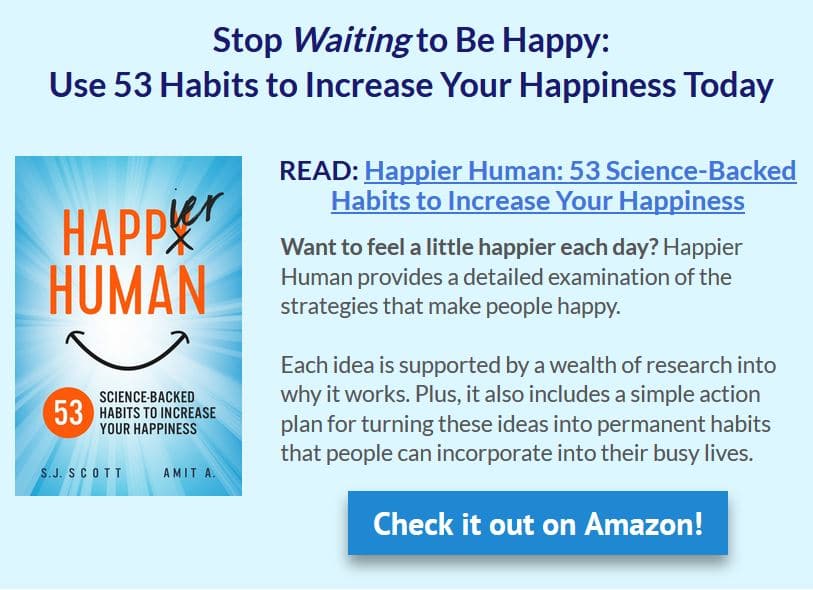There might be affiliate links on this page, which means we get a small commission of anything you buy. As an Amazon Associate we earn from qualifying purchases. Please do your own research before making any online purchase.
You can increase your long-term happiness by almost 10% with a simple, fun and free 5-minute exercise.1
Here's the exercise: “Write down three things that went well each day and their causes every night for one week. In addition, provide a causal explanation for each good thing.”
That's it. We spend tens of thousands of dollars on expensive electronics, homes, automobiles, and vacations hoping for a 10% boost. There is a free alternative, and it works.
In a study of exercise's effectiveness by Martin Seligman, participants were asked to follow those exact instructions for just one week.
After one week they were 2% happier than before, but in follow-up tests, their happiness kept on increasing, from 5% at one month, to 9% at six months. All this, even though they were only instructed to journal for one week. Participants enjoyed the exercise so much, that they just kept on doing it on their own.
I tried it for myself – I set a goal of doing it for just one week.
It's Addictive & Effective.
Here's why:
Because of hedonic adaptation, we get use to the good things in our life. It makes sense that we get tired of our old car and of our old wife. From an evolutionary perspective, it's good to upgrade to a new model; it's good to get more food, build bigger houses, and construct pointier weapons. But it sucks for our happiness.
Remember the last time you bought yourself a nice toy? It could be a game, a car, a TV, a piece of clothing … anything that you bought because you expected it to give you happiness. It probably made you happy, but for how long? More specifically, when did it make you happy?
Your material good made you happy when you were consciously thinking about it. Taking the example of a TV, the first few times you sat down to watch it, you actually thought about the features of the TV. You might have thought, “the quality is so much better than that old piece of junk I had” or, “I'm so glad I bought it, the size is great.” Whatever it was you though, there was some form of appreciation. Appreciation creates happiness. It happened automatically.
And then it stopped. There were no more recognition – no more conscious thoughts. It becomes a part of your reality, undeserving of your mental time. With that change, you lost its happiness, forcing you to seek out the next toy.
We already have all the toys we need.
This exercise, called ‘Three Good Things”, fights that loss and counteracts adaption. By taking the time to consciously express gratitude, we remember that we already have in our lives things we should be grateful and happy for. Doing this exercise actually feels good.
A counter study published in April suggests that there is nothing special about the ‘Three Good Things' exercise. It hypothesizes that any exercise which involves positive thoughts can increase happiness.2
It may not be scientifically clear why it works, but it is clear that is does, having been proven several times to increase long-term happiness. Unfortunately, the longest time period measured was six-months. Is it possible that happiness levels would have continued increasing?
Yes – it is. One the one hand, it's possible that the exercise was getting more effective the more it was practiced. Generating gratitude is an undeveloped skill. Mastering it is much like loving-kindness meditation. At first, you're halfway decent, generating a slight bump of happiness. As you progress, that bump slowly transforms into a sustained rise.
On the other hand, happiness triggers positive feedback loops. My gratitude journal usually focuses on other people. Because I am generating gratitude for them, when I actually meet them in person I tend to be especially kind. They in turn are nicer to me, which then makes me even happier!
To begin your own gratitude habit, I recommend you get The 90-Day Gratitude Journal. Its simple writing prompts are a powerful tool for developing an attitude of gratitude, which are designed to raise your happiness and appreciation for all that you have in life.
Give it a go – just set a goal to do it for one week. You won't regret it, and it will definitely take less willpower than your other goals!
See all the benefits of gratitude in this comprehensive guide.
Finally, one proven way to improve your happiness and life satisfaction is to focus on goals that truly matter. To get started, check out this FREE printable worksheet and a step-by-step process that will help you set effective SMART goals.

This post is part of the Month of Happiness project.
Check out the rest!
- Day 1: Psychostimulants: They might give you happiness; they might give you a heart attack
- Day 2: How to Harness the Power of Laughter: An Easy, Effective, and Infinite Source of Joy
- Day 3: Three Good Things, A Small Gratitude Exercise for a Large Boost of Happiness
- Day 4: The Right Way to Fake a Smile For Health and Happiness
- Day 5: Emotional Contagion: 5 Ways to Get Your Environment to Work for You
- Day 6: Ditch Porn – It’s Playboy on (Dopamine Draining) Steroids
- Day 7: Why I “Remain” an Introvert, Though the Science Suggests Extroverts are Happier
- Day 8: Yoga – It Isn’t Just for Female Hipsters
- Day 9: Watch More TV; It Makes You Happy!
- Day 10: Kaizen: Accomplishing Big Goals With Small Actions
- Day 11: Omega-3 Supplementation – Good For The Heart & Vitamin Shoppe’s Bottom Line
- Day 12: Good Sleep: Not Optional for Happiness and High Performance
- Day 13: One Tab at a Time: 7 Tips to Browse Social Media More Mindfully
- Day 14: Optimism, The Blind Man’s Gamble
- Day 15: A Story of Change, The 5 Willpower Techniques That Create Action
- Day 16: Zest, The Spice of Life… or is it?
- Day 17: Exercise: Better than Zoloft
- Day 18: Relaxation: The Magic Tonic That Cures Headaches & Relieves Indigestion
- Day 19: Spirituality for the Irreligious – Getting the Benefits Outside the Cathedral
- Day 20: Meditation – The Good, The Bad, and The Ugly Beautiful
References
1. Seligman, M. P., Steen, T. A., Park, N., & Peterson, C. (2005). Positive Psychology Progress. American Psychologist, 60(5), 410-421. doi:10.1037/0003-066X.60.5.410
2. Mongrain, M., & Anselmo-Matthews, T. (2012). Do Positive Psychology Exercises Work? A Replication of Seligman et al. (). Journal Of Clinical Psychology, 68(4), 382-389. doi:10.1002/jclp.21839


Amit, this is making me wanna get back to my gratitude journal. I used to keep it in my purse, but now I think it’s in the trunk of my car… Oops. It really did bring me happiness though, to reflect on all of the little blessings in my life. I never really thought about the causes – but I can see how that’d just amplify the effects of the exercise.
I’ll be givin’ this one a whirl. 🙂
Hahahaha 🙂
I feel you. There are so many things I know I should do (that are super easy!), but still don’t.
I think a 10% increase in long-term happiness is pretty huge, so I’ve been tracking my daily compliance on a whiteboard. I don’t want to stop doing something that has the potential to provide so much value. Hopefully you’ll have better luck this time too!